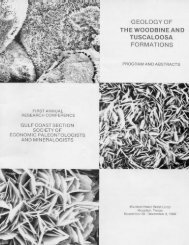Petroleum Systems of Deep-Water Basins - Gulf Coast Section SEPM
Petroleum Systems of Deep-Water Basins - Gulf Coast Section SEPM
Petroleum Systems of Deep-Water Basins - Gulf Coast Section SEPM
Create successful ePaper yourself
Turn your PDF publications into a flip-book with our unique Google optimized e-Paper software.
The Past and Future Exploration Potential <strong>of</strong> the<br />
<strong>Deep</strong> <strong>Water</strong> <strong>Gulf</strong> <strong>of</strong> Mexico<br />
David B. Meyer<br />
Chevron North America Exploration and Production<br />
935 Gravier Street<br />
New Orleans, Louisiana 70112<br />
David B. Rains<br />
Geology and Geophysics<br />
Texas A&M University<br />
College Station, Texas 77843<br />
Abstract<br />
On October 16, 1975, Placid spudded the first deep water wildcat well in Mississippi Canyon block 113 initiating<br />
the exploration <strong>of</strong> the deep water <strong>Gulf</strong> <strong>of</strong> Mexico. Twenty-five years and 392 wildcats later, 121 discoveries have been<br />
made yielding an estimated ultimate recovery (EUR) <strong>of</strong> 10.6 billion barrels <strong>of</strong> oil equivalent (BOE) reserves. Fields<br />
such as Auger, Mars/Ursa, Crazy Horse, and Mad Dog demonstrate that field reserves <strong>of</strong> 300 million to 1 BBOE are<br />
possible and that significant potential (10–20 BBOE) remains for the next generation <strong>of</strong> drilling in 2001 and beyond.<br />
An accurate assessment <strong>of</strong> risk and reserves is critical for the prudent investment <strong>of</strong> future plays in the <strong>Deep</strong>water<br />
<strong>Gulf</strong> <strong>of</strong> Mexico. To achieve this, an understanding <strong>of</strong> drilled wells and trends is necessary. For this project, all wildcats<br />
in water depths greater than 400 meters (1,300 feet) were grouped into a specific tectonic setting, stratigraphic<br />
age, and trap style, which ensured meaningful statistical analyses. Tectonic settings included basins (extensional),<br />
fold belts (compressional), Sigsbee plain, and subsalt. The major stratigraphic ages are Pleistocene, Pliocene, and<br />
Miocene, and the four possible trap styles are 4-way anticline, 3-way faulted structure, salt/shale truncation, and<br />
stratigraphic.<br />
At present, 88% <strong>of</strong> the wells have tested structures in basins, resulting in a 32% success rate, an average <strong>of</strong> 68<br />
MMBOE/discovery totaling 7.5 BBOE reserves. The remaining 12% are in the subsalt (26 wells) and foldbelt (19<br />
wells) tectonic settings. These have success rates <strong>of</strong> 27% and 26%, respectively. The subsalt has yielded 2 BBOE,<br />
averaging 285 MMBOE per discovery. The foldbelt has contributed 1.1 BBOE with an average <strong>of</strong> 230 MMBOE per<br />
discovery.<br />
The first half <strong>of</strong> 2001 has already added 500 MMBOE reserves and should total 1 BBOE by year-end. This will be<br />
the fourth year in a row that the one billion barrel mark <strong>of</strong> added reserves has been achieved. Two world records have<br />
also been set. Unocal set a world record for water depth by drilling the Trident prospect in Alaminos Canyon block<br />
903 in 9,687 feet <strong>of</strong> water. Chevron set a world record for total depth drilled with the Poseidon prospect in Mississippi<br />
Canyon block 727, which drilled to 29,750 feet. Continued advances in deepwater drilling, development, and production<br />
technology and seismic imaging will allow industry to tap the vast potential <strong>of</strong> the fold belt and subsalt areas <strong>of</strong><br />
the deepwater <strong>Gulf</strong> <strong>of</strong> Mexico.<br />
31

















